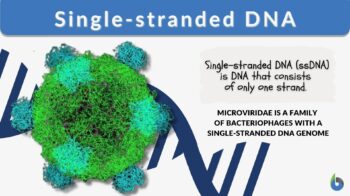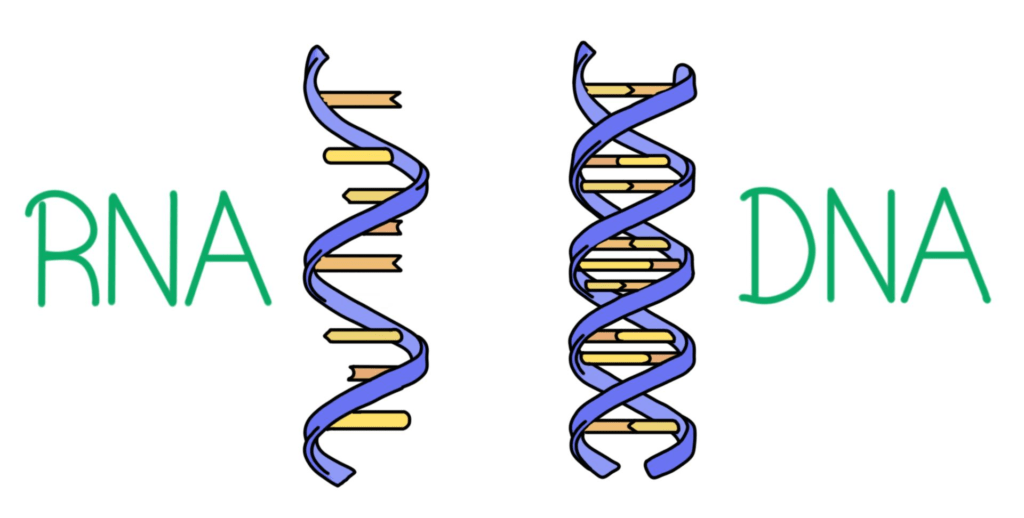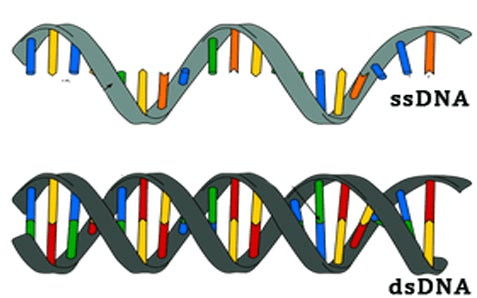
Single-stranded DNA
n.,
Definition: DNA of only one strand.
Credit: Microvirus diagram (Fdardel, CC BY-SA 3.0)
Table of Contents
What is single-stranded DNA?
DNA is the material that living organisms possess that carries their genetic make-up. DNA and RNA are sometimes confused with each other. DNA is deoxyribonucleic acid whereas RNA stands for ribonucleic acid. DNA is found in every organism and in every cell of an organism. It is what makes the organism unique since no two organisms contain the same DNA.
Even twins, who genetically share the same DNA coding, as not exactly genetically identical. RNA on the other hand a nucleic acid present in organisms that help with cellular, genetic processes. They help with code and decoding as well as the regulation and expression of genetic material.
DNA and RNA have their similarities and differences, especially in structure.
Is RNA single-stranded? Is DNA single-stranded?
Both molecules can be single-stranded nucleic acids. Which molecule is always single-stranded? RNA is always single-stranded and is often referred to as single-stranded ribonucleic acid. This can be seen in Figure 1 below. However, DNA can be either double-stranded or a single strand of DNA (ssDNA).

What is ssDNA? The ssDNA definition is as follows:
Single-stranded DNA is the single DNA strand that is created during the replication process of DNA. The replication of single-stranded DNA forms two separate single-stranded chromosomes that join together to form double-stranded DNA (dsDNA). Single-stranded DNA genome also exists in class II of viruses known as the Parvoviridae and bacteriophages called microviridae.
When DNA is heated artificially, it can also cause the double-stranded helix to separate and break, forming single-stranded DNA as well.
How long is a strand of DNA? DNA is a very compact molecule and so it fits into cells with no issues. However, if a strand of DNA was to be expanded to its full length, it would be almost 2 meters long.
Single-stranded DNA is a DNA molecule that consists of only a single strand contrary to the typical two strands of nucleotides in helical form. In nature, a single-stranded DNA genome can be found in Parvoviridae (class II viruses). Single-stranded DNA can also be produced artificially by rapidly cooling heat-denatured DNA. Heating causes the strands to separate while rapid cooling prevents them from renaturation. See also: DNA
Single-stranded DNA Examples
As mentioned previously, single-stranded DNA can be found in three ways: (1) during the replication of dsDNA, (2) as the ssDNA genome in parvoviridae and microviridae, and (3) when dsDNA is artificially separated using heat. An image of ssDNA vs dsDNA can be seen in Figure 2 below:

- During the replication of dsDNA – DNA polymerase is responsible for the replication of dsDNA. When the DNA splits, creating the DNA replication fork, it will replicate each side of the dsDNA, creating two single-stranded DNA. These two single strands will then be bound together by single-stranded DNA binding proteins and create more copies of the dsDNA. (READ: DNA Replication) However, when the cell is in distress, it can cause the single-stranded chromosomes to not bind together, creating many ssDNAs in the cell. This creates genome instability and is a potential site for mutations and recombination issues in the cell. The accumulation of the ssDNA in the DNA is usually caused by the uncoupling of helicase units and replication fork polymerase. This issue can lead to problems within the organism if they usually have dsDNA present in their nucleus. These problems can be those such as genetic diseases and cancer.
- As the ssDNA genome in parvoviridae and microviridae – Some viruses that are members of the family microviridae have genomes that contain single-stranded DNA. This is present as simple — just a strand of nucleotides that is very long. These viruses have DNA that does not need or have two strands that will complement each other and so bind together, leaving them as single-stranded DNA genome viruses. Seawater, marine microbial mats, extreme environments, freshwater, terrestrial environments, metazoan-associated mats and sediments are all places where these viruses that contain single-stranded DNA can be found. Some examples of these kinds of viruses are Canine parvovirus – a contagious parvoviridae virus that affects dogs and Bdellovibrio bacteriovorus – a microviridae that is a host-dependent bacterium.
- When dsDNA is artificially separated and forms ssDNA – There are numerous artificial methods used to separate dsDNA to form ssDNA. These can range from treatment with salt or NaOH as well as direct heating methods. These are called the denaturation of DNA. This is also the best way to split DNA as it usually results in two, whole single-stranded DNA chromosomes. When the strands are separated, the heat is removed or the mixture is neutralized in order to prevent the strands from rejoining together. Heat denaturing is the most simple and the easiest way to undergo the splitting of the dsDNA. However, it is not the most accurate method and the use of DNA sequencing might be a better substitute for it. Denaturing with NaOH can take great amounts of time depending on the concentration of the chemical. The benefit of using NaOH to denature DNA is that it can be renatured by the addition of phosphate buffer. On the other hand, generally other salt denaturing methods cannot be reversed. Once the bonds between the dsDNA strands are broken they will not be able to be reformed. Sometimes, the denaturing with salt works better when it is accompanied by heat. It is also usually assisted by some kind of chemical like ethanol. This process is highly specific and accurate and so can be used on large quantities of DNA.
Try to answer the quiz below to check what you have learned so far about single-stranded DNA.
References
- Cotmore, S. F., Agbandje-McKenna, M., Canuti, M., Chiorini, J. A., Eis-Hubinger, A.-M., Hughes, J., Mietzsch, M., Modha, S., Ogliastro, M., Pénzes, J. J., Pintel, D. J., Qiu, J., Soderlund-Venermo, M., Tattersall, P., Tijssen, P., & ICTV Report Consortium. (2019). ICTV Virus Taxonomy Profile: Parvoviridae. Journal of General Virology, 100(3), 367–368. https://doi.org/10.1099/jgv.0.001212
- Difference Between ssDNA and dsDNA. (n.d.). Compare the Difference Between Similar Terms. Retrieved December 22, 2021, from https://www.differencebetween.com/difference-between-ssdna-and-dsdna/
- How long is your DNA? – BBC Science Focus Magazine. (n.d.). Retrieved December 22, 2021, from https://www.sciencefocus.com/the-human-body/how-long-is-your-dna/
- Liautard, J. P. (1984). Rapid separation of single-stranded DNA from double-stranded DNA by reversed-phase high-performance liquid chromatography. Journal of Chromatography A, 285, 221–225. https://doi.org/10.1016/S0021-9673(01)87756-6
- Maffeo, C., & Aksimentiev, A. (2017). Molecular mechanism of DNA association with single-stranded DNA binding protein. Nucleic Acids Research, 45(21), 12125–12139. https://doi.org/10.1093/nar/gkx917
- Maier, B., Bensimon, D., & Croquette, V. (2000). Replication by a single DNA polymerase of a stretched single-stranded DNA. Proceedings of the National Academy of Sciences, 97(22), 12002–12007. https://doi.org/10.1073/pnas.97.22.12002
- Man, T. P. (n.d.). The Top Methods for DNA Denaturation. Retrieved December 22, 2021, from https://info.gbiosciences.com/blog/the-top-methods-for-dna-denaturation
- Sabatinos, S. A., & Forsburg, S. L. (2015). Managing Single-Stranded DNA during Replication Stress in Fission Yeast. Biomolecules, 5(3), 2123–2139. https://doi.org/10.3390/biom5032123
- Single-Stranded DNA – an overview | ScienceDirect Topics. (n.d.). Retrieved December 22, 2021, from https://www.sciencedirect.com/topics/biochemistry-genetics-and-molecular-biology/single-stranded-dna
©BiologyOnline.com. Content provided and moderated by Biology Online Editors.



